Intel Core i5 3470 Review: HD 2500 Graphics Tested
by Anand Lal Shimpi on May 31, 2012 12:00 AM EST- Posted in
- CPUs
- Intel
- Ivy Bridge
- GPUs
HD 2500: Compute & Synthetics
While compute functionality could technically be shoehorned into DirectX 10 GPUs such as Sandy Bridge through DirectCompute 4.x, neither Intel nor AMD's DX10 GPUs were really meant for the task, and even NVIDIA's DX10 GPUs paled in comparison to what they've achieved with their DX11 generation GPUs. As a result Ivy Bridge is the first true compute capable GPU from Intel. This marks an interesting step in the evolution of Intel's GPUs, as originally projects such as Larrabee Prime were supposed to help Intel bring together CPU and GPU computing by creating an x86 based GPU. With Larrabee Prime canceled however, that task falls to the latest rendition of Intel's GPU architecture.
With Ivy Bridge Intel will be supporting both DirectCompute 5—which is dictated by DX11—but also the more general compute focused OpenCL 1.1. Intel has backed OpenCL development for some time and currently offers an OpenCL 1.1 runtime that runs across multiple generations of CPUs, and now Ivy Bridge GPUs.
Our first compute benchmark comes from Civilization V, which uses DirectCompute 5 to decompress textures on the fly. Civ V includes a sub-benchmark that exclusively tests the speed of their texture decompression algorithm by repeatedly decompressing the textures required for one of the game’s leader scenes. And while games that use GPU compute functionality for texture decompression are still rare, it's becoming increasingly common as it's a practical way to pack textures in the most suitable manner for shipping rather than being limited to DX texture compression.
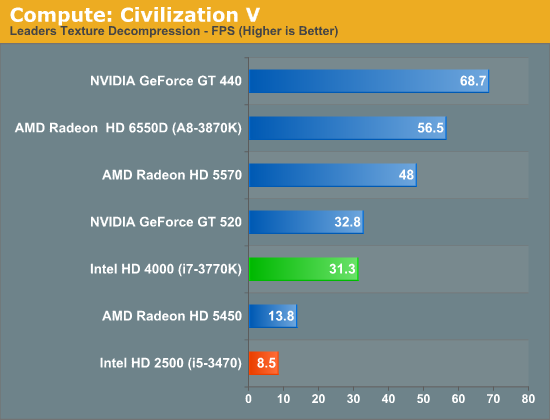
These compute results are mostly academic as I don't expect anyone to really rely on the HD 2500 for a lot of GPU compute work. With under 40% of the EUs of the HD 4000, we get under 30% of the performance from the HD 2500.
We have our second compute test: the Fluid Simulation Sample in the DirectX 11 SDK. This program simulates the motion and interactions of a 16k particle fluid using a compute shader, with a choice of several different algorithms. In this case we’re using an (O)n^2 nearest neighbor method that is optimized by using shared memory to cache data.
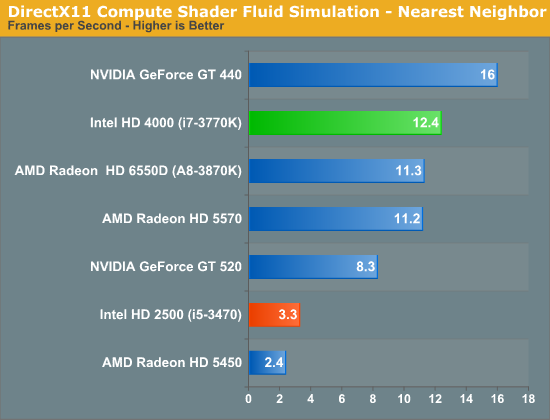
Thanks to its large shared L3 cache, Intel's HD 4000 did exceptionally well here. Thanks to its significantly fewer EUs, Intel's HD 2500 does much worse by comparison.
Our last compute test and first OpenCL benchmark, SmallLuxGPU, is the GPU ray tracing branch of the open source LuxRender renderer. We’re now using a development build from the version 2.0 branch, and we’ve moved on to a more complex scene that hopefully will provide a greater challenge to our GPUs.
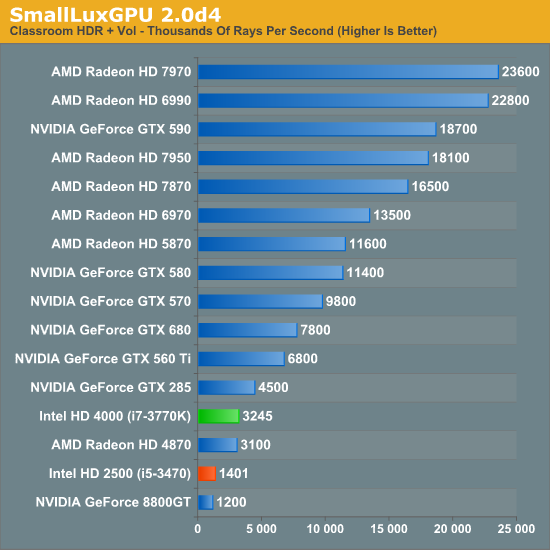
Intel's HD 4000 does well here for processor graphics, delivering over 70% of the performance of NVIDIA's GeForce GTX 285. The HD 2500 takes a big step backwards though, with less than half the performance of the HD 4000.
Synthetic Performance
Moving on, we'll take a few moments to look at synthetic performance. Synthetic performance is a poor tool to rank GPUs—what really matters is the games—but by breaking down workloads into discrete tasks it can sometimes tell us things that we don't see in games.
Our first synthetic test is 3DMark Vantage’s pixel fill test. Typically this test is memory bandwidth bound as the nature of the test has the ROPs pushing as many pixels as possible with as little overhead as possible, which in turn shifts the bottleneck to memory bandwidth so long as there's enough ROP throughput in the first place.
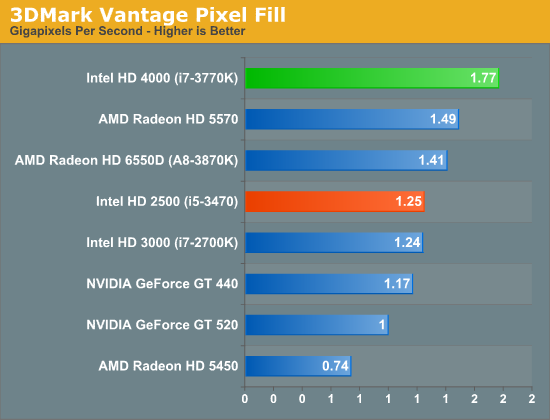
It's interesting to note here that as DDR3 clockspeeds have crept up over time, IVB now has as much memory bandwidth as most entry-to-mainstream level video cards, where 128bit DDR3 is equally common. Or on a historical basis, at this point it's half as much bandwidth as powerhouse video cards of yesteryear such as the 256bit GDDR3 based GeForce 8800GT.
Moving on, our second synthetic test is 3DMark Vantage’s texture fill test, which provides a simple FP16 texture throughput test. FP16 textures are still fairly rare, but it's a good look at worst case scenario texturing performance.
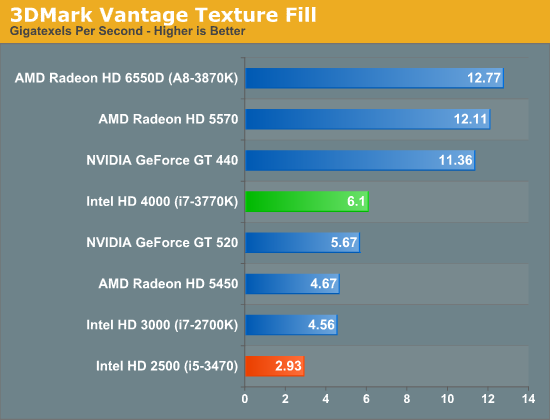
Our final synthetic test is the set of settings we use with Microsoft’s Detail Tessellation sample program out of the DX11 SDK. Since IVB is the first Intel iGPU with tessellation capabilities, it will be interesting to see how well IVB does here, as IVB is going to be the de facto baseline for DX11+ games in the future. Ideally we want to have enough tessellation performance here so that tessellation can be used on a global level, allowing developers to efficiently simulate their worlds with fewer polygons while still using many polygons on the final render.
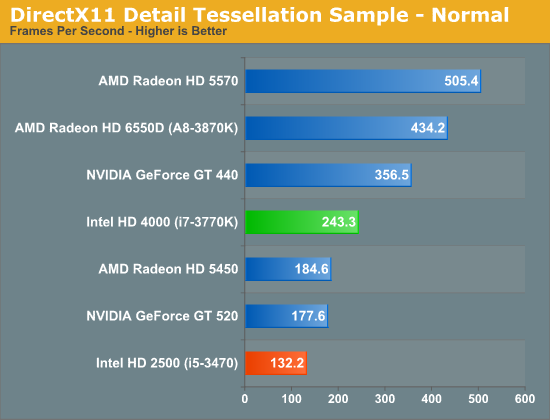
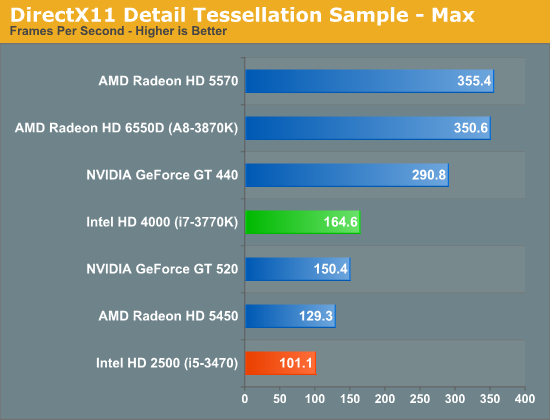
The results here are as expected. With far fewer EUs, the HD 2500 falls behind even some of the cheapest discrete GPUs.
GPU Power Consumption
As you'd expect, power consumption with the HD 2500 is tangibly lower than HD 4000 equipped parts:
| GPU Power Consumption Comparison under Load (Metro 2033) | ||||
| Intel HD 2500 (i5-3470) | Intel HD 4000 (i7-3770K) | |||
| Intel DZ77GA-70K | 76.2W | 98.9W | ||
Running our Metro 2033 test, the HD 4000 based Core i7 drew nearly 30% more power at the wall compared to the HD 2500.










67 Comments
View All Comments
Ryan Smith - Thursday, May 31, 2012 - link
Your completely right. We were in a rush and copied that passage from our original IVB review, which is no longer applicable.SteelCity1981 - Thursday, May 31, 2012 - link
Intel could have at least called it a 3500 and slap 2 more EU's onto it.fic2 - Thursday, May 31, 2012 - link
Agreed. I don't understand why Intel basically stood pat on the low end HD.But then again like everyone else I never understood why the HD3000 was only in the K series and maybe 5% of K series users don't have discreet gpu so the HD3000 isn't being used.
CeriseCogburn - Monday, June 11, 2012 - link
Good point. Lucid logic tried to fix that some, and did a decent job, and don't forget quick sync, plus now with zero core amd cards, and even low idle power 670's and 680's, leaving on SB K chip hd3000 cores looks even better - who isn't trained in low power if they have a video card, after all it's almost all people rail about for the last 4 years.So if any of that constant clamor for a few watts power savings has any teeth whatsoever, every person with an amd card before this last gen will be using the SB HD3000 and then switching on the fly to gaming with lucid logic.
n9ntje - Thursday, May 31, 2012 - link
So this must be a midrange desktop chip? Horrendous performance on the graphics side from Intel again.Very curious how AMD's trinity dekstop will perform, at the same pricerange it will be obvious it will obliterate Intel's offerings on the graphics side. What's more impressive AMD is still on 32nm..
7Enigma - Thursday, May 31, 2012 - link
For me this IS the perfect chip. No use for the GPU so cheaper = better. I would need a K model though for OC'ing potential, but I'm glad to see that if I can't have my CPU-only (no GPU) chip, at least I can have a hacked down version that is more in line with a traditional CPU.silverblue - Thursday, May 31, 2012 - link
What Intel should really be doing here is offering the 4000 on all i3s and some i5s to offset the reduced CPU performance. If you want to give AMD something to think about, HD 4000 on an Ivy Bridge dual core is very much the right way of going about it.CeriseCogburn - Friday, June 1, 2012 - link
Then Intel has a lame trinity level cpu next to a losing gpu.I think Intel will stick with it's own implementations, don't expect to be hired as future product manager.
ShieTar - Thursday, May 31, 2012 - link
Interestingly enough, Intel will also happily sell you what is basically the same chip, without any GPU, 100 MHz slower but with 2MB extra L3-Cache for the same price. They call that offer Xeon E3-1220V2. And it is 69W TDP, not 77W as the i5-3470.Who knows, the bigger Cache might even make it the better CPU for a not-overclocking gamer. If normal boards support it.
Pazz - Thursday, May 31, 2012 - link
Anand,Following on from your closing statement with regards to the HD 4000 being the miniumum, will you be doing a review of the 3570K? Surely with this model being the lowest budget Ivy HD4000 chip, it'll be a fairly popular option for many system builders and OEM's.